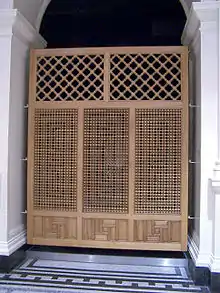
Latticework is an openwork framework consisting of a criss-crossed pattern of strips of building material, typically wood or metal. The design is created by crossing the strips to form a grid or weave.[1] Latticework may be functional – for example, to allow airflow to or through an area; structural, as a truss in a lattice girder;[2] used to add privacy, as through a lattice screen; purely decorative; or some combination of these.
Latticework in stone or wood from the classical period is also called Roman lattice or transenna (plural transenne).
In India, the house of a rich or noble person may be built with a baramdah or verandah surrounding every level leading to the living area. The upper floors often have balconies overlooking the street that are shielded by latticed screens carved in stone called jalis which keep the area cool and give privacy.[3]
Examples
.jpg.webp) Lattice screen at Amber Fort
Lattice screen at Amber Fort Latticework window in Iran
Latticework window in Iran Eiffel Tower structural latticework
Eiffel Tower structural latticework Lattice truss bridge in Vermont
Lattice truss bridge in Vermont